any news ?It would be interesting to know which components fail in the D20400.
And a second question:
What is the main issue with the replica of the original circuit from Ultra Analog (at least according the images in post #38 under
Ultra Analog D20400 datasheet?
a circuit diagram should actually be made) ?
Schematic you will get here:
https://www.ebay.com/itm/115121794212
Seems to me like there is a string DAC for first 8 MSBs and DAC7541 for 12 LSBs. Also a sample-hold system is used on the output to deal against glitches.
Similiar DAC to this architecture can be AD1865 (or AD1862 with all bits).
The main issue with the 1:1 replica is a CPLD digital logic for the string part. It must be fast and it is almost impossible to create with glue logic. So you will need to program VHDL or verilog code for CPLD to replicate it correctly.
Similiar DAC to this architecture can be AD1865 (or AD1862 with all bits).
The main issue with the 1:1 replica is a CPLD digital logic for the string part. It must be fast and it is almost impossible to create with glue logic. So you will need to program VHDL or verilog code for CPLD to replicate it correctly.
Maybe this is the reason, why all me known replicas for replacement of the genuine Ultra Analog DAC module use the good known vintage DAC ICs from Burr Brown and Analoge Devices (i. e., actually not real replicas).Seems to me like there is a string DAC for first 8 MSBs and DAC7541 for 12 LSBs. Also a sample-hold system is used on the output to deal against glitches.
Similiar DAC to this architecture can be AD1865 (or AD1862 with all bits).
The main issue with the 1:1 replica is a CPLD digital logic for the string part. It must be fast and it is almost impossible to create with glue logic. So you will need to program VHDL or verilog code for CPLD to replicate it correctly.
But I cannot believe, that an I/U converter with NE5532 for PCM63 provide sufficiently good sonic results.
What of the replicas from attached images is is closest to Ultra Analog' D20400/D20400a ?
I guess, those with AD1862, but I know it exactly.
How difficult is a replica by use of the old M72H035 (no datasheet and other information on the web) from OKI/Mitsubishi (of course, this only comes into question if this MCU is not the cause of the fault from defective potted original modules) ?
Attachments
-
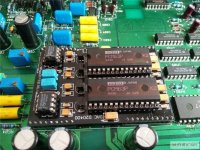 D20400 Repl PCM63-II.jpeg134.3 KB · Views: 264
D20400 Repl PCM63-II.jpeg134.3 KB · Views: 264 -
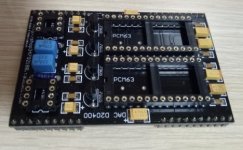 D20400 Repl PCM63.jpg42.6 KB · Views: 210
D20400 Repl PCM63.jpg42.6 KB · Views: 210 -
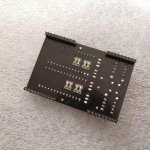 PCM63 for D20400 solder site.jpg127.1 KB · Views: 199
PCM63 for D20400 solder site.jpg127.1 KB · Views: 199 -
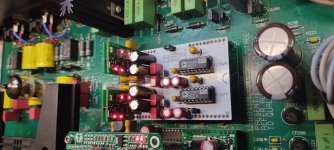 D20400 Repl AD1862.jpg155.1 KB · Views: 230
D20400 Repl AD1862.jpg155.1 KB · Views: 230 -
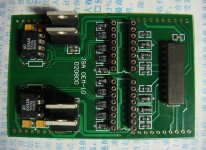 D20400 Repl PCM1702.jpeg126.5 KB · Views: 221
D20400 Repl PCM1702.jpeg126.5 KB · Views: 221 -
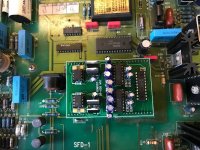 D20400 Repl PCM1702-II.jpeg131.8 KB · Views: 219
D20400 Repl PCM1702-II.jpeg131.8 KB · Views: 219 -
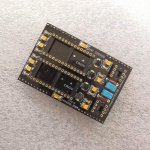 1pc-HIFI-PCM63-DAC-module-Replaces-UltraAnalog-D20400-Dual-2-0-Audio-DAC.jpg141.1 KB · Views: 215
1pc-HIFI-PCM63-DAC-module-Replaces-UltraAnalog-D20400-Dual-2-0-Audio-DAC.jpg141.1 KB · Views: 215 -
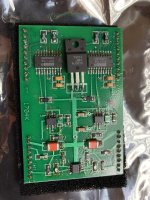 D20400 Repl PCM1704.jpg417.7 KB · Views: 261
D20400 Repl PCM1704.jpg417.7 KB · Views: 261
Last edited:
After closer look into that schematic I see that the first 8 MSBs are not string but classical R-2R.
AD1862 is close but not closest, ... PCM63 is also not the closest.
It is difficult to replicate. It can be done with the use of DAC7541 (or another R-2R DAC with parallel inputs) + a discrete R-2R DAC for first 8 MSBs ... best if driven by CPLD (because sample and hold is used).
AD1862 is close but not closest, ... PCM63 is also not the closest.
It is difficult to replicate. It can be done with the use of DAC7541 (or another R-2R DAC with parallel inputs) + a discrete R-2R DAC for first 8 MSBs ... best if driven by CPLD (because sample and hold is used).
The real clever part of the Ultra Analog DAC module as I was told by a DAC expert is the way the individual resistors are trimmed to get best THD. The algorithm to do that is UA's significant IP as I understand it - just duplicating the BOM list won't give you the resistor values you need to build one.
The PCM54 do have also parallel inputs (16 Bits, used e. g. Nakamichi OMS series).After closer look into that schematic I see that the first 8 MSBs are not string but classical R-2R.
AD1862 is close but not closest, ... PCM63 is also not the closest.
It is difficult to replicate. It can be done with the use of DAC7541 (or another R-2R DAC with parallel inputs) + a discrete R-2R DAC for first 8 MSBs ... best if driven by CPLD (because sample and hold is used).
https://pdf1.alldatasheet.com/datasheet-pdf/view/56845/BURR-BROWN/PCM54HP.html
What features in the circuit topology actually made the D20400 superior to the integrated circuits PCM63, PCM1702 and PCM1704 in terms of sound quality ?
While several listening sessions It became evident in the integrated circuits from Burr Brown and Cirrus Logic important aspects of the design were not considered that would have been necessary.
Last edited:
DAC7821 is still produced and very close alternative to the DAC7541. You can buy it new from mouser.
I never listened to the D20400, so I am not sure if it sounds better (especially on the same I/V topology). It can sounds very good due to the discrete MSBs, but AD1862, AD1865 or PCM63 are from TOP competitors
If there is someone with D20400 who compare it directly with these chips (on the same I/V and the same PSU) with the result: D20400 is better in all aspects, then it would be worth replicating
I never listened to the D20400, so I am not sure if it sounds better (especially on the same I/V topology). It can sounds very good due to the discrete MSBs, but AD1862, AD1865 or PCM63 are from TOP competitors
If there is someone with D20400 who compare it directly with these chips (on the same I/V and the same PSU) with the result: D20400 is better in all aspects, then it would be worth replicating
I was working at Silicon General. I designed an audio AD. It was sold to a few companies. We visited "New England Digital" and they wanted to improve their DA. We agreed to do it. So I designed that DA. It was a resistor based designed to overcome the problems associated with "standard R-2R network". This was before audio use of "sigma delta" technology.The PCM54 do have also parallel inputs (16 Bits, used e. g. Nakamichi OMS series).
https://pdf1.alldatasheet.com/datasheet-pdf/view/56845/BURR-BROWN/PCM54HP.html
What features in the circuit topology actually made the D20400 superior to the integrated circuits PCM63, PCM1702 and PCM1704 in terms of sound quality ?
While several listening sessions It became evident in the integrated circuits from Burr Brown and Cirrus Logic important aspects of the design were not considered that would have been necessary.
New England Digital did not buy the DA's. At first, they postponed the purchase (they were focused on software issues), and soon after, they closed shop. Around that time, my boss Dick Powers invited me and Remmie (good digital engineer) to a meeting with his ex boss, Bernie Gordon (Analogic and more). Bernie agreed to subsidize Ultra Analog. I did not join the operation, but a couple of Dick Powers people did. They took that DA design and repackaged it. The original unit used through hole technology. The packaging was much improved with mostly surface mount parts. I don't know what else they did to it, and I stopped paying attention a long time ago. Also, Ultra Analog is long gone.
Unlike a DA module, the DA924/2002 offers a complete unit (digital and analog inputs and outputs). The DA924/2002 structure is different and is self calibrated on startup. The jitter removal is optimized for stereo. The product does not compare to the Dan-5.
Dan Lavry
interesting details. I guess, there are at whole a large amount of old users of D/A converters from those days, which are fault due defective modules and thus occurs great efforts over the last 20 years to create replicas of this potted modules from Ultra Analog (all me known only with the good known integrated DAC's).I was working at Silicon General. I designed an audio AD. It was sold to a few companies. We visited "New England Digital" and they wanted to improve their DA. We agreed to do it. So I designed that DA. It was a resistor based designed to overcome the problems associated with "standard R-2R network". This was before audio use of "sigma delta" technology.
New England Digital did not buy the DA's. At first, they postponed the purchase (they were focused on software issues), and soon after, they closed shop. Around that time, my boss Dick Powers invited me and Remmie (good digital engineer) to a meeting with his ex boss, Bernie Gordon (Analogic and more). Bernie agreed to subsidize Ultra Analog. I did not join the operation, but a couple of Dick Powers people did. They took that DA design and repackaged it. The original unit used through hole technology. The packaging was much improved with mostly surface mount parts. I don't know what else they did to it, and I stopped paying attention a long time ago. Also, Ultra Analog is long gone.
Unlike a DA module, the DA924/2002 offers a complete unit (digital and analog inputs and outputs). The DA924/2002 structure is different and is self calibrated on startup. The jitter removal is optimized for stereo. The product does not compare to the Dan-5.
Dan Lavry
In post #1 under
https://www.diyaudio.com/community/threads/ultra-analog-the-ghost-company.90495/
there is also an example of such an user who is looking for something like this.
At whole there are a lot of CD player and DAC models under
http://vasiltech.narod.ru/CD-Player-DAC-Transport.htm
(fill in "D20400" for getting line up resp. overview).
This guy under
https://www.ebay.com/itm/115121794212
does have a wiring diagram created, unfortunately only from those version where he removed the potting compound.
I know that there was a version D20400 and a version D20400a, possibly even within these two mentioned versions there were individual deviations or upgrades over the years.
Replicas based on the genuine approach with laser trimmed R2R network seems to be very difficult. But with help of all genuine documentations (maybe still exist with one of the mentioned engineers) and upgrades maybe it is possible to create a real compatible replica without the causes of the premature failures (at least for the mentioned digital engineers who design the D20400/D20400a).
Also the DAC-section from the complete unit under
http://www.hifidiy.net/index.php?s=/home/marticle/detail/id/6690.html
could be a possibility therefore.
A great deficiency on DA924 is the arrangement of the electrolytics near the heat sink of the voltage regulators - this means great thermal stress for this parts.
P.S.: Why were these D20400 modules cast with casting compound back then?
Attachments
Last edited:
I think this was mainly IP protection. As far as I know, no patents ever existed on the UA/Lavry approach.P.S.: Why were these D20400 modules cast with casting compound back then?
It could also be a means to spread heat in the module to get a better stability.
D20400 seems to be fully epoxy potted and D20400A only on the bottom of the PCB.
From my DNL measurements I made so far, the very early D20400 (STAX branded from 1989/90) seems to be significantly superior to D20400A of mid 90ies. A good 30 year old D20400 channel can be as good as 1..2ppm. So far I didn't see a D20400A being better than 5ppm, which is still great btw.. *)
Unfortunately no D20400A datasheet seems to exist. From that perspective I would suggest that the D20400A was a "Light" OEM Version of the D20400 and it's specification intentionally kept secret.
The only person, who potenially could shed some light on that would be Dr. Rémy Fourré, who is the guy who actually engineered these modules.
So far we have a schematics of a typical D20400A and product literature about D20400...
*) To put that into the right Multibit perspective: TDA1541A-S1: ~15ppm (unfortunately at 0Fs and 16bit only), PCM1704-K: 20ppm, unadjusted PCM63-K 25ppm, unadjusted AD1862-Z: 5ppm (unfortunately at 0Fs), MSB Platinum DAC: 100ppm (fortunately not at 0Fs), Lavry DA-N5: 0.5..1 ppm (Not proven to be R2R, but likely), freshly adjusted Lavry DA2002: 4ppm (Unfortunately "plagued" by a >20ppm glitch with strong AC signals).
Last edited:
According this values my estimate from post #24 is right concerning best currently available replacement for the D20400a (fourth image of AD1862 module).I think this was mainly IP protection. As far as I know, no patents ever existed on the UA/Lavry approach.
It could also be a means to spread heat in the module to get a better stability.
D20400 seems to be fully epoxy potted and D20400A only on the bottom of the PCB.
From my DNL measurements I made so far, the very early D20400 (STAX branded from 1989/90) seems to be significantly superior to D20400A of mid 90ies. A good 30 year old D20400 channel can be as good as 1..2ppm. So far I didn't see a D20400A being better than 5ppm, which is still great btw.. *)
Unfortunately no D20400A datasheet seems to exist. From that perspective I would suggest that the D20400A was a "Light" OEM Version of the D20400 and it's specification intentionally kept secret.
The only person, who potenially could shed some light on that would be Dr. Rémy Fourré, who is the guy who actually engineered these modules.
So far we have a schematics of a typical D20400A and product literature about D20400...
*) To put that into the right Multibit perspective: TDA1541A-S1: ~15ppm (unfortunately at 0Fs and 16bit only), PCM1704-K: 20ppm, unadjusted PCM63-K 25ppm, unadjusted AD1862-Z: 5ppm (unfortunately at 0Fs), MSB Platinum DAC: 100ppm (fortunately not at 0Fs), Lavry DA-N5: 0.5..1 ppm (Not proven to be R2R, but likely), freshly adjusted Lavry DA2002: 4ppm (Unfortunately "plagued" by a >20ppm glitch with strong AC signals).
Until know to this day I always thought that Dr. Rémy Fourré a specialist of circuit topologies for jitter reduction is - e. g. like this:
https://www.hifido.co.jp/sold/05-25031-61445-00.html?LNG=E
https://www.canuckaudiomart.com/details/649735127-sonic-frontiers-ultra-jitter-bug/
go also to
https://www.stereophile.com/content/jitterbuggin
https://www.stereophile.com/features/368/index.html
https://www.physicsforums.com/threads/can-someone-explain-jitter-commonsensically.123470/ (post #4)
Der D20400 without suffix "a" was in use here (both with tubes for output stage - maybe also for low pass filter:
1) VTL Reference
https://www.stereophile.com/digitalprocessors/vtl_reference_da_processor/index.html
2) Stax X1T
https://www.hifiengine.com/gallery/images/stax-dac-xt1-vacuum-tube-output-da-converter.shtml
https://www.audio-markt.de/en/market/stax-x1t-tube-dac-converter-5400829550
Maybe there are additional papers not to find on the web.
Attachments
-
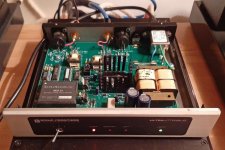 jjRqP.jpg68.4 KB · Views: 177
jjRqP.jpg68.4 KB · Views: 177 -
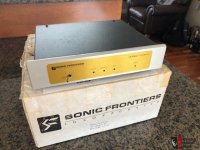 3253288-e005a14b-sonic-frontiers-ultra-jitter-bug.jpg51.6 KB · Views: 138
3253288-e005a14b-sonic-frontiers-ultra-jitter-bug.jpg51.6 KB · Views: 138 -
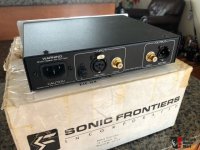 3253289-604db55f-sonic-frontiers-ultra-jitter-bug.jpg51.3 KB · Views: 124
3253289-604db55f-sonic-frontiers-ultra-jitter-bug.jpg51.3 KB · Views: 124 -
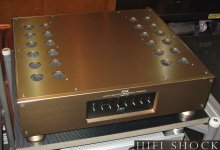 phoca_thumb_l_dac-x1t-0-stax.jpg147.2 KB · Views: 116
phoca_thumb_l_dac-x1t-0-stax.jpg147.2 KB · Views: 116 -
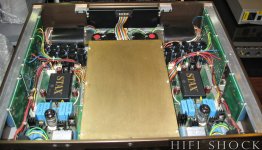 phoca_thumb_l_dac-x1t-1b-stax.jpg262.4 KB · Views: 118
phoca_thumb_l_dac-x1t-1b-stax.jpg262.4 KB · Views: 118 -
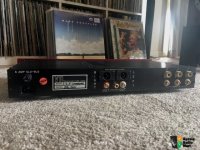 2330681-600a3d19-vtl-reference-dac-20bit-ultraanalog-d20400.jpg62.3 KB · Views: 124
2330681-600a3d19-vtl-reference-dac-20bit-ultraanalog-d20400.jpg62.3 KB · Views: 124 -
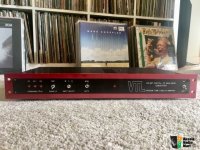 2330679-53a3cb12-vtl-reference-dac-20bit-ultraanalog-d20400.jpg69.3 KB · Views: 120
2330679-53a3cb12-vtl-reference-dac-20bit-ultraanalog-d20400.jpg69.3 KB · Views: 120 -
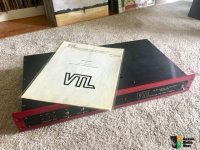 2330680-7d6f98e2-vtl-reference-dac-20bit-ultraanalog-d20400.jpg70.5 KB · Views: 133
2330680-7d6f98e2-vtl-reference-dac-20bit-ultraanalog-d20400.jpg70.5 KB · Views: 133 -
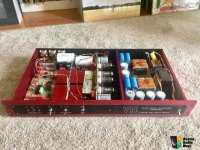 2330683-b09be49d-vtl-reference-dac-20bit-ultraanalog-d20400.jpg79.6 KB · Views: 151
2330683-b09be49d-vtl-reference-dac-20bit-ultraanalog-d20400.jpg79.6 KB · Views: 151
Last edited:
Has anyone ever seen an Ultra Analog module, exact same wording on the module as D20400, but "DAC13" in place of "D20400"? I was able to get one of these modules on eBay a while back and the seller said he bought it as spares (drop-in replacements) for his D20400 based DAC.
Also, is it required to provide input to the "HOLD" input, or only if you want do deviate from the standard timing (2.0 µS wide for D20200 and 1.5 µS wide for D20400 and D18400)? I was able to get the module to work on a breadboard using TDA1541 simultaneous mode and just left the HOLD input unconnected.
If input is needed, does anyone have a recommendation on a circuit to generate the required input?
Also, is it required to provide input to the "HOLD" input, or only if you want do deviate from the standard timing (2.0 µS wide for D20200 and 1.5 µS wide for D20400 and D18400)? I was able to get the module to work on a breadboard using TDA1541 simultaneous mode and just left the HOLD input unconnected.
If input is needed, does anyone have a recommendation on a circuit to generate the required input?
According to my list the DAC0013 was a modified version of the early D20400 customized for the early VTL and Manley Reference DACs. There could be some minor differences regarding output stage gain, but I would expect, it to be pin compatible to D20400/A.
D20400 can run in most D20400A circuits and vice versa, but there seems to be some minor incompatibility. The monst annoying one, ist that D20400A has rectangular pins and D20400 has thin round precision pins, which means, that both can't work in the same type of socket.
Most variants (like the DAC0013) have an internal deglitcher, which should be used, otherwise the glitches will increase the distortion dramatically.
The HOLD input can be connected to the DG outputs of classic NPC and PMD digital filters (Unfortunately DF1704/DF1706 don't have it).
If you don't have a DG/HOLD signal available, you could use the Wordclock of the DAC. One option would be to delay all signals to the dac by at least one clock cycle (e.g. HC574) and using the original undelayed wordclock as HOLD (beware of polarity). If the Wordclock has a 50% dutycycle, it could work.
The HOLD is the most critical digital signal and should provide the lowest jitter of any signal. One can achieve this e.g. by reclocking it by the MCLK signal or any other low jitter clock.
From what I know only the DAC0018 (Spectral SDR-2000) and P/N 340022 (Sonic Frontiers Processor 3, DAC0022 ??) variants don't come with internal deglitcher, but need an external one instead.
You can't properly use any of the D20400 variants without a deglitcher !
D20400 can run in most D20400A circuits and vice versa, but there seems to be some minor incompatibility. The monst annoying one, ist that D20400A has rectangular pins and D20400 has thin round precision pins, which means, that both can't work in the same type of socket.
Most variants (like the DAC0013) have an internal deglitcher, which should be used, otherwise the glitches will increase the distortion dramatically.
The HOLD input can be connected to the DG outputs of classic NPC and PMD digital filters (Unfortunately DF1704/DF1706 don't have it).
If you don't have a DG/HOLD signal available, you could use the Wordclock of the DAC. One option would be to delay all signals to the dac by at least one clock cycle (e.g. HC574) and using the original undelayed wordclock as HOLD (beware of polarity). If the Wordclock has a 50% dutycycle, it could work.
The HOLD is the most critical digital signal and should provide the lowest jitter of any signal. One can achieve this e.g. by reclocking it by the MCLK signal or any other low jitter clock.
From what I know only the DAC0018 (Spectral SDR-2000) and P/N 340022 (Sonic Frontiers Processor 3, DAC0022 ??) variants don't come with internal deglitcher, but need an external one instead.
You can't properly use any of the D20400 variants without a deglitcher !
I wonder, why no datasheet for the D20400A is released resp. anywhere on the web to find despite the fact, that the D20400 is much more rare than the D20400A.D20400 can run in most D20400A circuits and vice versa, but there seems to be some minor incompatibility. The monst annoying one, ist that D20400A has rectangular pins and D20400 has thin round precision pins, which means, that both can't work in the same type of socket.
Guys if you want VHDL code or tutorial for CPLD converter "I2S to D20400", here it is 
https://electrodac.blogspot.com/p/i2s-to-d20400-converter-tutorial.html
@psmith001 tested it with his D20400 module (DAC0013)
https://electrodac.blogspot.com/p/i2s-to-d20400-converter-tutorial.html
@psmith001 tested it with his D20400 module (DAC0013)
Hey all,
I have an 30-year-old SFD-1 DAC with the epoxied UA module in it, and I think it's failing...
The DAC has audible crackling, hissing and all around distortion, that randomly comes in and out at any time (used to be just upon startup). I've tried troubleshooting all areas I could, next is the power supply caps and tube sockets, but I've already tried everything I can think of to rule out other causes.
Question is: is this what a dying D20400A module sounds like? Or could it be some different issue?
2nd question: does the AD1862 replacement module sound at least similar to the OG UA modules in SFD-line DACs?
I've already bought the AD replacement from PCX, but I'd like to keep the original UA module at all costs if I can, even if that means eating the $315 I paid for the module.
I have an 30-year-old SFD-1 DAC with the epoxied UA module in it, and I think it's failing...
The DAC has audible crackling, hissing and all around distortion, that randomly comes in and out at any time (used to be just upon startup). I've tried troubleshooting all areas I could, next is the power supply caps and tube sockets, but I've already tried everything I can think of to rule out other causes.
Question is: is this what a dying D20400A module sounds like? Or could it be some different issue?
2nd question: does the AD1862 replacement module sound at least similar to the OG UA modules in SFD-line DACs?
I've already bought the AD replacement from PCX, but I'd like to keep the original UA module at all costs if I can, even if that means eating the $315 I paid for the module.
check out this offer:Hey all,
I have an 30-year-old SFD-1 DAC with the epoxied UA module in it, and I think it's failing...
The DAC has audible crackling, hissing and all around distortion, that randomly comes in and out at any time (used to be just upon startup). I've tried troubleshooting all areas I could, next is the power supply caps and tube sockets, but I've already tried everything I can think of to rule out other causes.
Question is: is this what a dying D20400A module sounds like? Or could it be some different issue?
2nd question: does the AD1862 replacement module sound at least similar to the OG UA modules in SFD-line DACs?
I've already bought the AD replacement from PCX, but I'd like to keep the original UA module at all costs if I can, even if that means eating the $315 I paid for the module.
https://www.ebay.com/itm/115841160514
- Home
- Source & Line
- Digital Line Level
- UltraAnalog D20400 DATA ! I have it all !!